Hydrangea rough Sargent - how to grow an ornamental shrub
The bright and attractive Sargent hydrangea, native to eastern China, is found in the wild in dense forests, valleys and on slopes, as well as at an altitude of 700-1800 m above sea level. The cultivar was named after the American botanist Charles Sprague Sargent. Consider the main features of the culture, the rules for planting and leaving it.
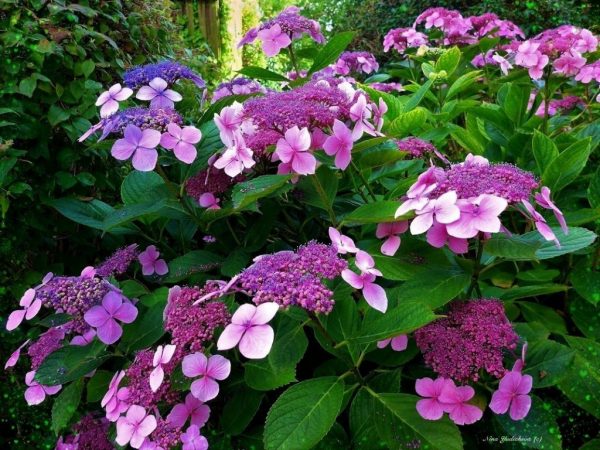
Hydrangea sargent ornamental trees and shrubs
Characteristic
Hydrangea Sargent is a deciduous shrub with erect, rigid, slightly branched, shoots from 1 to 2 m in height. Latin name: Hydrangea aspera sargentiana. Family: Hortensiae.
The plant is characterized by intensive growth - the annual growth is 20-25 cm. The winter hardiness zone is 6-7 (-23 ° C). When grown in regions with a cold and continental climate, it needs good insulation of the root area. It blooms for a long time - from late July to the first half of September.
External parameters:
- the bark on the stems is brown, peeling, on young stems it is covered with thick, bristly hairs;
- the root system is well developed, close to the surface;
- the leaves are large, 30x15-16 cm in size, ovoid with a sharp tip, emerald above, rough, gray-green below, velvety;
- flowers are flat, collected in umbellate or corymbose inflorescences with a circumference of 15-20 cm, color light purple or light purple;
- several sterile white flowers with a diameter of 2-3 cm bloom at the top of the buds.
Landing rules
Timing
The best time for planting is mid or late April, when the last frosts have passed and the soil warms up to 10 ° C.
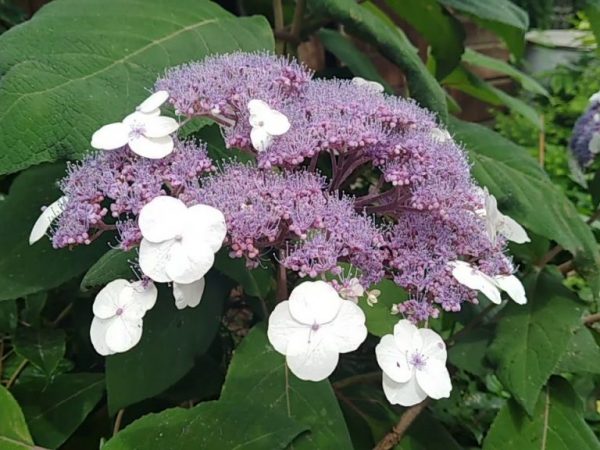
Hydrangea rough sargent
In the south, it can be planted in early autumn - until the first half of September.
Place and soil
The plant is thermophilic and requires good lighting, but when grown in direct sunlight, flowers and leaves burn quickly. Therefore, an area with slight shading at lunchtime is suitable. Also, when planting, it is worth considering that the perennial does not tolerate drafts and swampiness.
A well-drained, slightly acidic soil with a moderate nutrient content is suitable. The optimum acidity level is 4-5 units.
Sapling selection
The best planting material is considered to be seedlings 2-3 years old. They have a well-developed aerial part and rhizome. When buying in a gardening nursery, inspect their crown - it should not show signs of infection with diseases, pests, as well as mechanical injuries.
Buy plants in an earthen coma or planted in a container. Before planting, the root system is immersed in cold water for a couple of hours, then pruned to 2-3 cm in length to stimulate the emergence of new shoots.
Landing technique
In group cultivation, the scheme is observed - 1-2x1.5 m.The size of the pits is 40x40x50 cm.
A little drainage is poured onto the bottom (pebbles, crushed stone, brick chips).Then sprinkle it 15 cm deep with a mixture of compost, leafy earth, peat and sand (2: 2: 1: 1). The roots are lowered so that the root collar is 3-4 cm above the soil surface, tamped, watered. Water consumption per seedling - 25 liters.
After that, they mulch with peat or humus so that the moisture does not quickly evaporate.
Care features
All care for this perennial comes down to several activities.

Hydrangea sargent winter hardiness
Watering
The culture is moisture-loving, therefore it is watered often, but in moderation, focusing on the condition of the soil (if it has dried out to a depth of 5-6 cm) and the amount of seasonal precipitation.
After planting, young seedlings are watered every other day to help them take root faster and grow.
Be sure to water in early spring, before and after flowering, and in autumn, when the shrub enters a dormant phase. Then the soil is loosened, weeded, weeds are removed, and a layer of peat or compost mulch is added to the tree trunk circle.
Top dressing
In the third year of life, they begin to fertilize several times per season:
- at the beginning of spring, 40 g of urea, 50 g of superphosphate and 35 g of potassium sulfate are laid around the bush;
- before flowering, 80 g of superphosphate and 45 g of potassium sulfate are introduced;
- in late autumn sprinkle with compost or last year's manure - 10 kg per 1 m².
Important! After feeding, abundant watering is carried out.
Pruning
This perennial, whose crown dies off for the winter, needs a cardinal haircut. It is carried out on the eve of the first frost - the entire aerial part is cut off to the base.
In the spring and summer, sanitary pruning is required to remove broken off, shriveled, growing inward and in the wrong direction of the shoots.
Preparing for winter
After the autumn haircut, they begin to warm the root zone - it is mulched with a thick layer of peat, sawdust or fallen leaves. Spruce branches are laid on top.
Reproduction
The shrub is propagated in two ways. Cutting and the seed method are not used, since these parts are poorly rooted and take root.
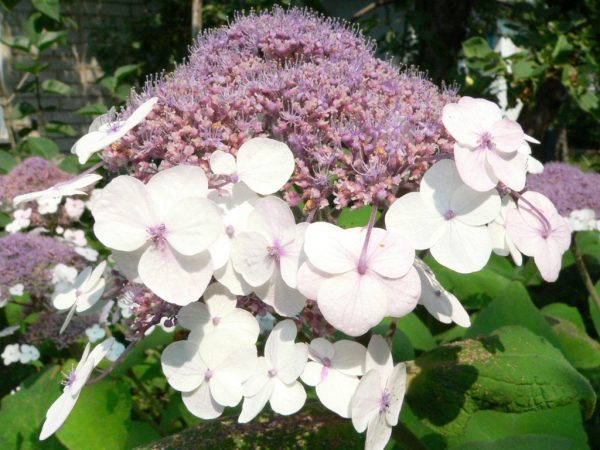
Hydrangea sargent photo
- Root shoots. The stems that have grown in the root zone are watered, carefully dug out with roots, separating them from the main rhizome. The sections are irrigated with a fungicide, and after drying, they are planted in a new habitat.
- By dividing the root. An old shrub that needs rejuvenation is moistened, then removed, cut into pieces with a garden shovel, so that each has several roots and one shoot. Places of cuts are powdered with charcoal. They are planted in the garden in the same way as purchased plants.
Diseases and pests
This perennial has several diseases and parasites that lead to loss of decorative qualities and death. The main cause of infection is improper care and violation of planting rules:
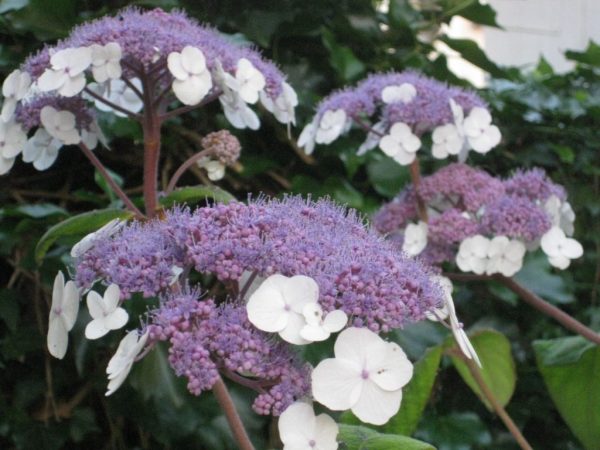
Hydrangea rough sargent winter hardiness
- Downy mildew, gray and white rot, septoria, ascochitis. Before treatment, remove all damaged areas, then irrigate the crown with one of the fungicides - Ridomil Gold, Skor, Topaz or Hom.
- Of the pests on the shrub, aphids, spider mites, meadow bugs, scoops, weevils appear. In the fight against these parasites, insecticides are used - Aktellik, Aktaru, Fitoverm, Karbofos and Fundazol.
For prevention, it is necessary to spray the bush with Bordeaux liquid or copper sulfate in early spring and autumn. You should also cut out the infected parts in time, regularly loosen the soil, remove weeds and follow the planting scheme.
Garden Decorating Ideas
Hydrangea is used as a tapeworm, as well as in group plantings with perennial crops - roses, azaleas, rhododendrons.
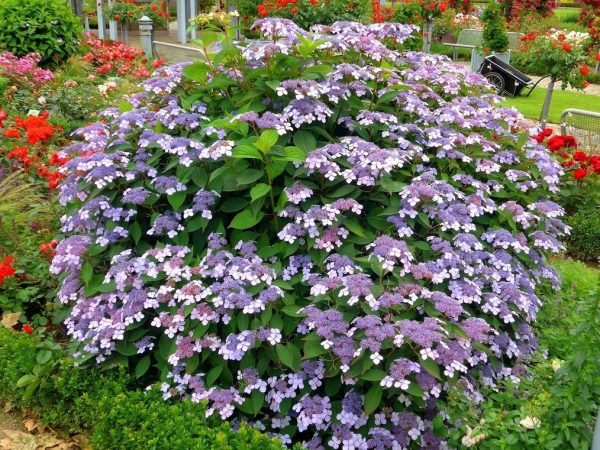
Hydrangea sargent does not bloom what is the reason
They are planted near gazebos, in alleys, along fences, in flower beds and in mixborders.
Testimonials
Due to its compact size, the ability to successfully develop on any type of soil, this plant has gained great popularity among flower growers:
- many fell in love with the variety for its long and bright flowering, which lasts until late autumn;
- others like it for successful reproduction and the possibility of obtaining varietal seedlings for landscaping the garden;
- also prized for its ability to grow fully when combined with a variety of flowers, shrubs and trees.

